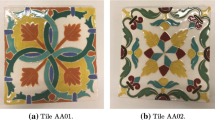Abstract
Nanotechnology is defined as design and production of structures, devices and systems by controlled manipulation of sizes and shapes at atomic, molecular. Through X-ray nano-CT, we have scanned archaeological artifacts that cannot be observed by human eyes without damaging cultural relics, so as to better study and restore protected cultural relics. The principles of X-ray fluoroscopy and fluorescence spectral analysis were introduced, which can obtain information about the internal structure, manufacturing process and erosion of cultural relics. These two techniques were applied to the detection of some bronzes in Shang and Zhou dynasties, and the detection images and data of two bronzes in Shang Dynasty were given. The preservation, casting process and alloy composition were analyzed and discussed. It is determined that the ware is cast by the mud block model method. The discussion and analysis tend to support that the alloy technology originated from the typical ternary alloy system in Shang and Zhou dynasties. During this period, craftsmen have summed up a set of scientific bronze alloy system.















Similar content being viewed by others
References
Mei JJ, Hirao Y, Natsumoto J, et al. (2005) Research on the ratio of lead isotopes in the early bronzes excavated in eastern regions of Xinjiang. Oriental Archaeol (2):303–311
Zhengyao J, Chase WT, Hirao Y, et al. (1994) Research on the ratio of lead isotopes in bronzes excavated in the tomb of Shang dynasty located in Dayangzhou town, Xingan county, Jiangxi province. Archaeology (8):744–747+735
Xiaohong W, Sixun Y (2000) The pretreatment of bone samples in high-precision 14C dating. Essays of Archaeometry (Volume II). Hefei:Press of University of Science and Technology of China (2):82–85
Li W (2011) Culture dictionary of Hunan (2). Hunan People’s Publishing House, Changsha, p 586
Bocao L (2002) Casting non-ferrous alloys. 2nd ed. Handbook of casting (Volume III). Beijing: China Machine Press p 335
Scott DA, Ying J (1995) Selective translation. Microstructure of ancient metals. Sci Conserv Archaeol 7(1):56–60
Tangkun H (1997) Synthetic study on the alloying technique for bronze in the pre-Qin period. Stud Hist Nat Sci 16(3):273–286
Ying Q, Guofeng W, Wenqi L et al (2005) Experiments on dissolving lead from bronze wares and the related questions. Sci Conserv Archaeol 17(2):16–18
Jueming H (1999) Ancient Chinese metal technology—civilization created by copper and iron. Elephant press, Zhengzhou, p 5
Rongyu Su, Jueming H, Kemin Li et al (1995) Ancient Chinese metal technology. Shandong Science and Technology Press, Jinan, pp 185–307
Turo FD (2020) Limits and perspectives of archaeometric analysis of archaeological metals: a focus on the electrochemistry for studying ancient bronze coins. J Cult Herit 43:271–281. https://doi.org/10.1016/j.culher.2019.10.006
Rademakers FW, Farci C (2018) Reconstructing bronze production technology from ancient crucible slag: experimental perspectives on tin oxide identification. J Archaeol Sci Rep 18:343–355. https://doi.org/10.1016/j.jasrep.2018.01.020
Funding
This article is a periodical result of the project which called research of bronzes in ba-yu area, and the number of the project is R2019FFY21.
Author information
Authors and Affiliations
Corresponding author
Ethics declarations
Conflict of interest
The author(s) declared no potential conflicts of interest with respect to the research, authorship and/or publication of this article.
Additional information
Publisher's Note
Springer Nature remains neutral with regard to jurisdictional claims in published maps and institutional affiliations.
Rights and permissions
About this article
Cite this article
Tan, X. Application of X-ray nano-CT fluoroscopy and fluorescence spectroscopy in the study of ancient bronzes. Nanotechnol. Environ. Eng. 7, 965–972 (2022). https://doi.org/10.1007/s41204-021-00200-6
Received:
Accepted:
Published:
Issue Date:
DOI: https://doi.org/10.1007/s41204-021-00200-6




